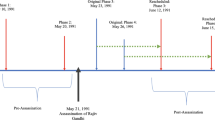Abstract
On 23 June 2016 a slight majority of 52% of UK voters opted to leave the European Union after 44 years of membership. Many were surprised by the result. Why did a majority vote Leave? Why were the majority of the voters not susceptible to the economic arguments advanced by major economic institutions such as the Bank of England, OECD, IMF, HM Treasury and virtually all major investment banks? Why did (now former) Prime Minister David Cameron, who campaigned for Remain, lose the vote only a year after his party had won a surprise victory in the 2015 general election?
Similar content being viewed by others
Author information
Authors and Affiliations
Corresponding author
Additional information
Matt Qvortrup, Coventry University, UK.
Rights and permissions
About this article
Cite this article
Qvortrup, M. Brexit as an Inelastic Good: A Microeconomic Theory of Direct Democracy. Intereconomics 51, 260–264 (2016). https://doi.org/10.1007/s10272-016-0615-x
Published:
Issue Date:
DOI: https://doi.org/10.1007/s10272-016-0615-x




